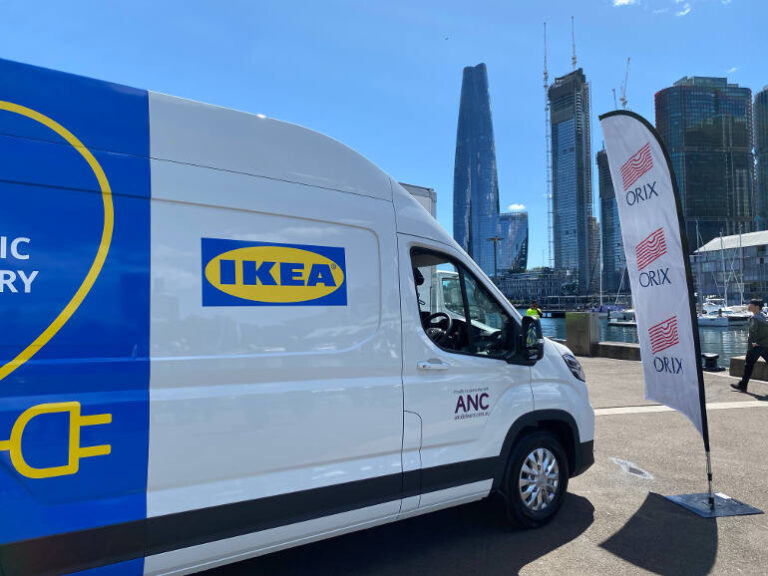In 2019, IKEA Australia announced they were introducing electric delivery vehicles and had set a target of zero emissions for all deliveries by 2025. In 2022 they have 10 electric delivery vehicles and are doubling down on the 2025 goal. I spoke to Brendan Groll, Customer Fulfilment Strategic Sourcing Manager at IKEA, to learn more about the journey so far, and the road ahead.
Can you give us a sense of how big the IKEA fleet is to start and how many deliveries you’re doing nationally?
Yeah, today we’ve got 10 electric vehicles in our fleet. We’ve been running those for a number of years. For us, we closely connect those to our truck deliveries, which is about 500,000 deliveries we do annually. And that’s from our 10 stores and three distribution centres today.
Your goal is to reach zero emissions deliveries by 2025. You started in 2019, then you’ve had COVID. So you’ve lost a few years, it’s an aggressive goal, will you get there?
Good question. We’ve actually been on the journey even longer than that, I could say we used to talk about alternative fuel and what that might look alike. But certainly, that crystallized into our electric vehicles, or zero emission strategy that we know today. And it is to have all of our deliveries and services executed with EV, or other zero emission vehicle types. By 2025. We might have lost a bit of time, but we have been active in the market and you know, trying to collaborate with different partners and OEMs to keep this alive.
You’ve got SEA trucks on the fleet, you’ve got some LDV vans, are there options coming into the market that you think you’ll be adopting?
There’s always new markets coming in? And I guess it’s about the technology available in those in that equipment? And is it suitable for our purpose? I think for us, we are trying to keep an open mind when it comes to vehicles that are available in the market. We use SEA today, and LDV. And there’s a couple of others. But we’re very interested in what’s going to hit the market. And we’ll continue to explore those options as they as they enter.
For an IKEA delivery, is there a typical size or shape or GVM of vehicle that you need to consider?
No. For us, we’re very open to any vehicle size, shape, and type. You know, everything’s on the table for us at the moment, we’re very serious about the goal. And getting to that 100% by 2025 is really important to us. So it means keeping an open mind to business models, vehicle types, and how we go about that. So there could be different industry players out there that are that are on this journey, we’d be really interested to engage with them and understand what their path looks like and what their strategy looks like. For us. Everything’s on the table.
Let’s talk about infrastructure. You’ve got some existing stores, and I’m sure you have plans to expand. How have you found retro fitting the charging infrastructure in existing locations, and planning for it in new buildings?
Obviously, infrastructure is a really important part to take in this positive step forward. Like I said, we’ve got 10 stores and three distribution centres and some of those are with partners. We are investing in our own sites to put EV charging infrastructure into those sites. But that alone is not going to get us to our goal. So when we talk about challenges, for example, the charging infrastructure available in the market is one of those key points that we’ve got to work with industry and try and overcome together.
So that’s interesting, even with your back-to-base delivery model, you think you’re still to need access to a public charging network?
Yeah, absolutely. I mean, for us, we’re on this transformation to being the best omni-channel retailer in the in the home furnishing space. And that means many customers everywhere, and where they want us to meet them. So for us, we did need to make sure that we can get into different areas, and therefore we need the vehicle types and the charging infrastructure for us to get there. It can’t just be relying on what we provide ourselves.
You’ve got 10 EVs now and 2025 as a goal, if I do the simple math, you’ll need buy several hundred EVs a year over the next couple of years. Is it achievable?
Well, we’re open to different business models and different approach here, we use the term blended. And for us blended means looking into the market and securing that capacity in various ways. And as I say, nothing’s off the table. But of course, it’s tapping into the market potential there today, platform providers, and of course, the traditional transport logistics operators that are out there. We’ll explore all of those options, but it is a significant number. However, we feel positive that with vehicles entering the market now we can get there. And further collaboration around financing solutions and charging infrastructure, we’ll be able to make it.
So just one last question about the global EV activity. Do you have any insight to how your colleagues around the world are performing? Are they closer to achieving the same challenge?
Absolutely. In terms of the goal setting, it’s probably worth noting that the goals are anchored with that global organisation and they collaborate with us in the markets around what is achievable. We’ve got things like prioritised cities where we’re making some really positive steps forward. Shanghai, New York, Paris and places like that. But we’re absolutely seeing most of the IKEA markets and are really developing quite fast and accelerating when it comes to EV. So this 100% goal We do feel is achievable.






